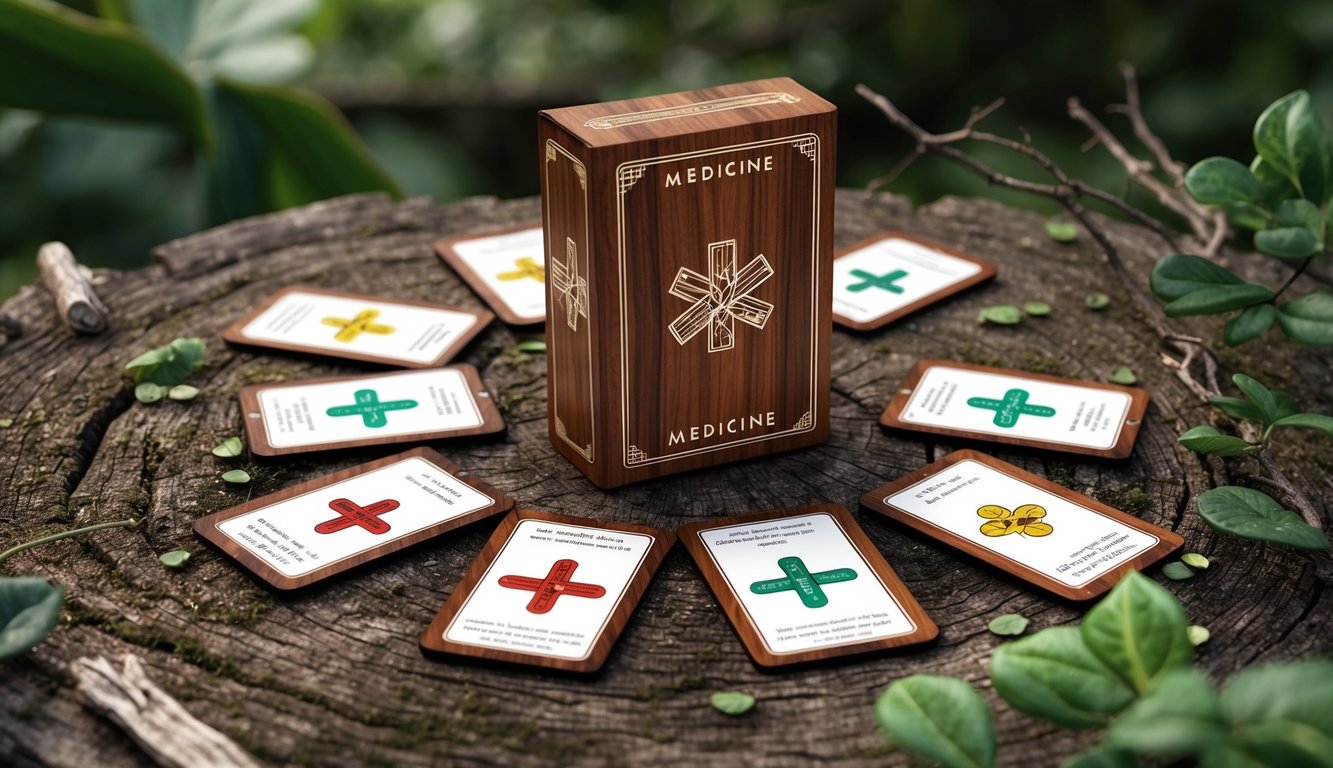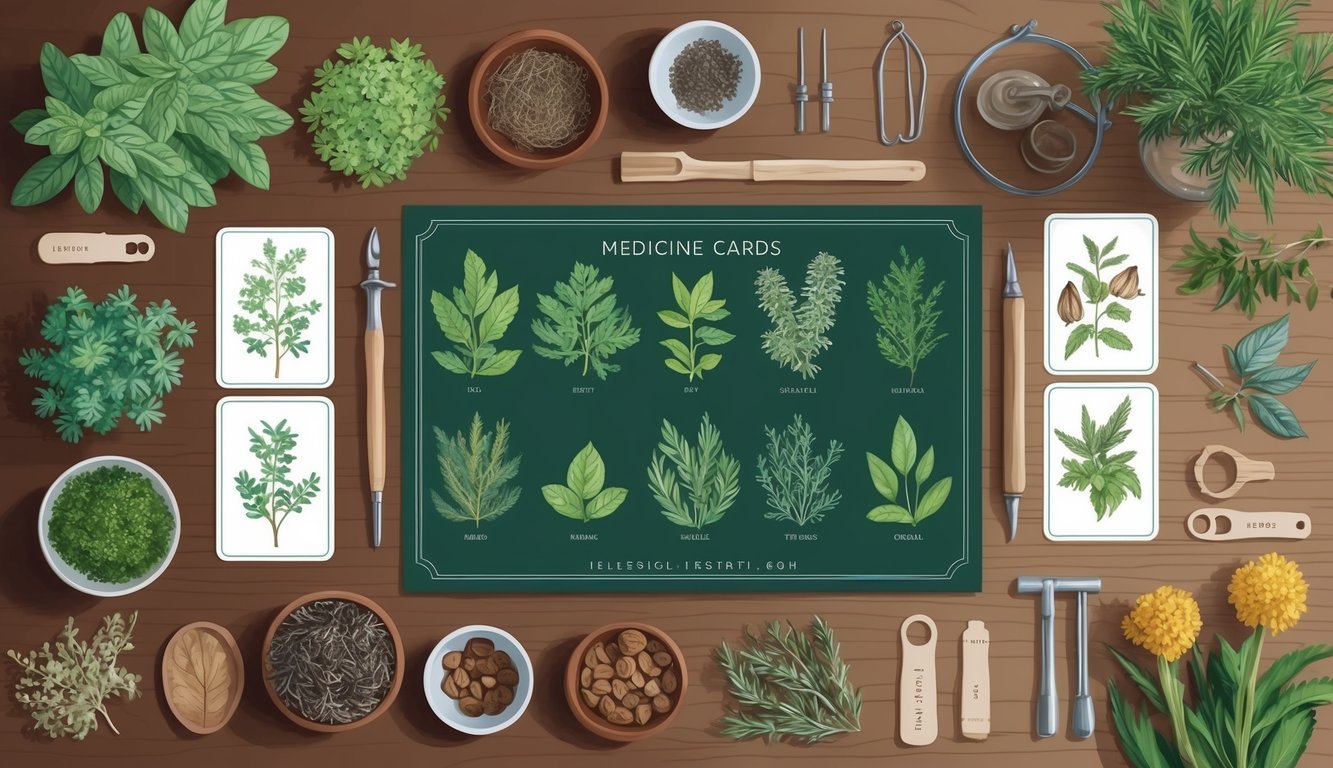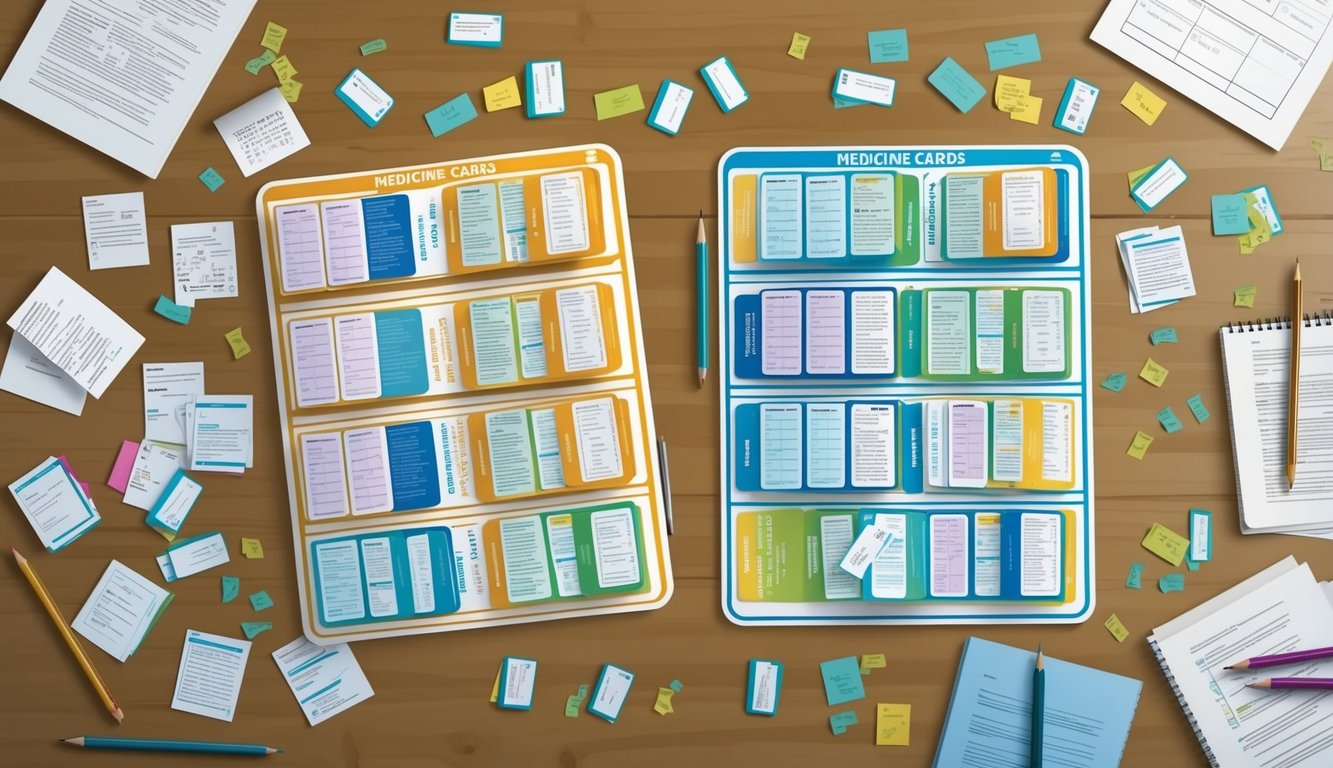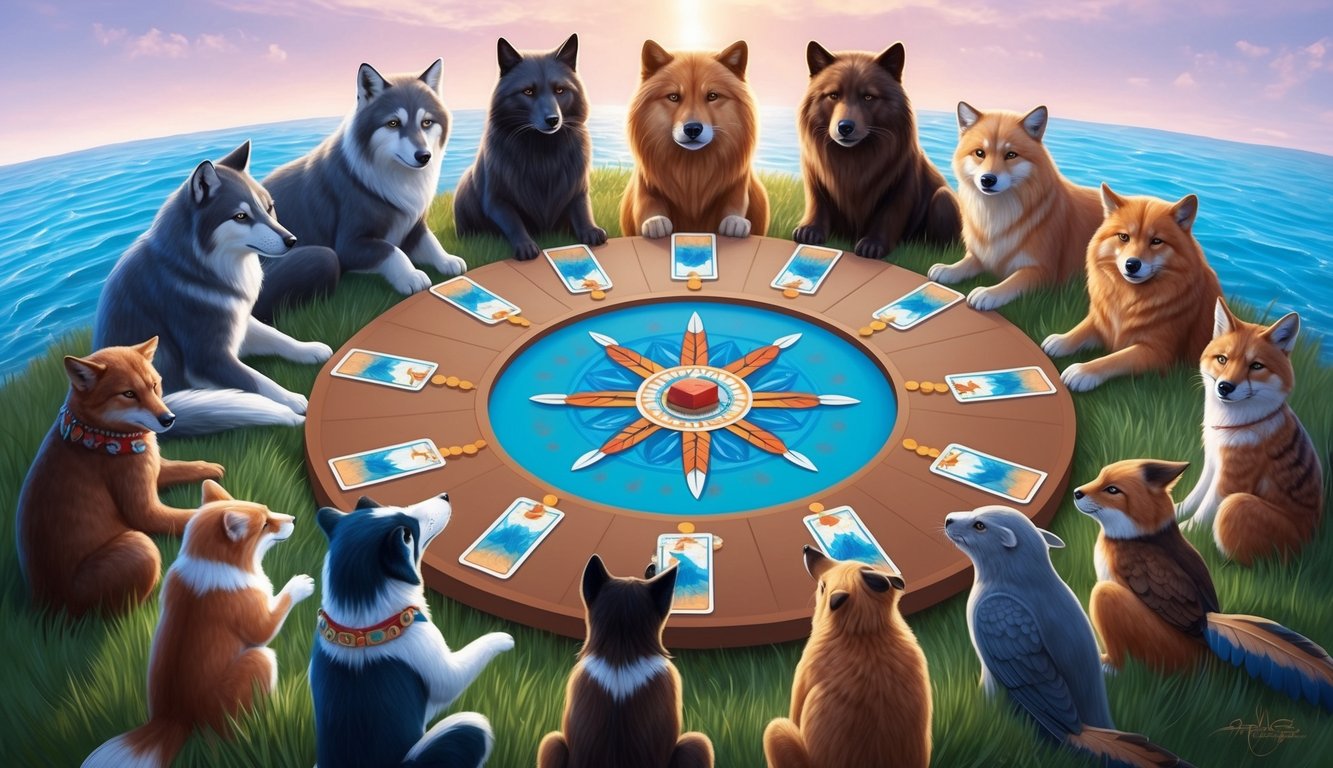Align Your Life with Your True North
The Power Quadrant System decodes your natural talents and pinpoints the career, timing and relationships that let you earn more, love deeper, and wake up eager for the day.
- Uncover your #1 high-income strength
- Draw in partners who raise your energy
- Work when your body’s clock is in “flow”
Have you ever felt drawn to the wisdom of nature and animals? Medicine cards offer a unique way to tap into this ancient knowledge.
These special decks combine Native American traditions with animal symbolism to provide guidance and insight into your life’s journey.
Medicine cards help you discover your inner power and connect with the natural world around you. Each card features an animal and its associated teachings, allowing you to draw upon their strengths and qualities.
As you work with these cards, you’ll gain a deeper understanding of yourself and your place in the universe.
Using medicine cards is simple and intuitive.
You can draw a single card for daily inspiration or perform more complex spreads for deeper reflection.
The animals’ messages can offer comfort, clarity, and direction when you need it most.
Whether you’re facing a tough decision or seeking personal growth, these cards can be a valuable tool on your path to self-discovery and healing.
Origins of Medicine Cards
Medicine cards emerged from Native American spiritual traditions, blending ancient wisdom with modern divination practices.
These cards tap into the symbolic power of animals to offer guidance and insight.
Historical Context
Medicine cards trace their roots to indigenous North American cultures.
Decode Your Personal Success Blueprint
Power Quadrant System shows you the exact career, relationships, and daily rhythm that match your natural DNA—so you earn more, work happier, and connect deeper.
- Pinpoint your #1 money-making talent
- Erase conflict & attract ideal partners
- Multiply productivity with perfect timing
Tribal elders and medicine people traditionally used animal symbolism in storytelling and healing rituals.
In 1988, Jamie Sams and David Carson formalized this concept by creating the “Medicine Cards: The Discovery of Power Through the Ways of Animals” deck.
This original set featured 44 animal cards, each representing specific qualities and energies.
The cards quickly gained popularity beyond Native American communities, appealing to those seeking spiritual guidance and self-reflection tools.
Cultural Significance
You’ll find that medicine cards hold deep cultural importance in Native American traditions.
They reflect a worldview that sees humans as interconnected with nature and animal spirits.
These cards serve as a bridge between ancient wisdom and contemporary spiritual practices.
They offer a way for you to connect with animal energies and gain insights into your life’s challenges.
Many people use medicine cards for personal growth, decision-making, and as a tool for spiritual ceremonies.
Tap Into Your Built-In Success GPS
The Power Quadrant System deciphers your genetic blueprint so you can lock onto the career, income and relationships that feel effortless—and wildly rewarding.
- Zero in on your natural high-earning genius
- Sync with partners who boost your vibe
- Wake up driven, finish days fulfilled
The cards’ popularity has led to translations in multiple languages, spreading their influence globally.
The Deck Overview
Medicine Cards combine animal wisdom with Native American spiritual traditions.
This unique divination system features beautifully illustrated cards and a companion book to help you gain insights and guidance.
Components and Structure
The Medicine Cards deck typically contains 44 cards, each depicting a different animal.
Every card showcases an animal in a medicine shield design, representing its spiritual essence and teachings.
The deck also includes blank cards for you to add personal animal allies.
Accompanying the cards is a guidebook that explains the symbolism and lessons associated with each animal.
For example, the elk card teaches about stamina, while the bear card represents introspection.
Common Themes
Animal wisdom and natural harmony are central themes in Medicine Cards.
You’ll find recurring motifs of balance, healing, and personal growth throughout the deck.
Each card offers profound insights, guiding individuals toward self-discovery and inner peace.
The teachings emphasize the importance of staying connected to nature’s rhythms, fostering a deeper understanding of oneself and the world.
Many of the messages align with balance quotes for life and work, encouraging harmony between personal well-being and professional responsibilities.
The cards encourage you to reconnect with nature and tap into your innate wisdom.
By drawing cards and reflecting on their meanings, you can gain insights into your life situations and spiritual journey.
Themes of transformation, strength, and intuition are woven throughout the animal teachings.
The deck aims to help you understand your unique purpose and find guidance for navigating life’s challenges.
Interpretations and Meanings
Medicine cards offer profound insights through animal symbolism and can be integrated into your daily life for guidance and self-reflection.
Each card’s meaning provides a unique perspective on your current situation or personal growth journey.
Animal Symbolism
In medicine card decks, animals represent specific qualities and energies.
For example, the turkey card symbolizes giving and sacrifice.
It encourages you to share your abundance and recognize the contributions of others.
The beaver card might represent industriousness and building, reminding you to work diligently towards your goals.
Each animal’s symbolism draws from Native American traditions and nature observations.
The wolf could represent loyalty and teamwork, while the eagle might symbolize vision and spiritual connection.
By understanding these animal attributes, you gain insight into your own strengths and areas for growth.
Integration in Daily Life
You can incorporate medicine cards into your daily routine for guidance and reflection.
Start your day by drawing a card and contemplating its message.
How might the animal’s qualities relate to your current challenges or aspirations?
Use the cards during decision-making processes.
Draw a card when facing a dilemma and consider how its wisdom applies to your situation.
Create a personal ritual, such as weekly card readings, to maintain a consistent practice of self-reflection and spiritual connection.
Try journaling about your card interpretations.
This practice can deepen your understanding of the cards’ meanings and help you track your personal growth over time.
Usage and Practices
Medicine cards serve as valuable tools for improving patient safety and medication management.
They offer opportunities for both individual reflection and group learning in healthcare settings.
Personal Reflection
You can use medicine cards to enhance your understanding of medications and their effects.
Create a set of cards for each drug you’re studying, including key information like generic and brand names, drug class, and mechanism of action.
When reviewing, quiz yourself on dosages, side effects, and contraindications.
This active recall method helps reinforce your knowledge.
Try color-coding your cards by drug class or using mnemonic devices to aid memory.
Update your cards regularly as you learn new information or encounter clinical experiences.
Keep a small set of frequently used drug cards handy during clinical rotations for quick reference.
Group Dynamics
Medicine cards can spark engaging discussions in study groups or clinical settings.
You and your peers can take turns presenting cards, challenging each other with questions about specific medications.
This collaborative approach helps identify knowledge gaps and reinforces learning through teaching others.
In healthcare teams, use medicine cards during huddles or rounds to review patient medications.
This practice promotes safer care by ensuring all team members are familiar with prescribed drugs.
You can also use cards to facilitate role-playing scenarios, simulating patient education or medication reconciliation processes.
Consider organizing card-based games or competitions to make learning more interactive and fun for your group.
These activities can improve medication knowledge retention and foster teamwork skills essential in healthcare settings.
Different Spreads and Readings
Medicine card readings offer various layouts to gain insight and guidance.
These spreads range from simple single-card draws to more complex multi-card arrangements, each providing unique perspectives on your questions or situations.
Single-Card Draw
A single-card draw is the simplest form of medicine card reading.
You shuffle the deck, focus on your question, and pull one card.
This method gives you a quick snapshot or daily guidance.
The drawn card represents the energy or animal spirit most relevant to your inquiry.
For example, if you draw the Dog card, it might suggest loyalty or companionship is key to your current situation.
Single-card draws are ideal for beginners or when you need a quick answer.
They’re also useful for daily meditation or reflection practices.
Multi-Card Spreads
Multi-card spreads offer more detailed readings by exploring different aspects of a situation.
The Medicine Wheel Spread is a popular choice, using five cards to represent the four directions plus a center card.
In this spread, you place cards for East, South, West, North, and Center.
Each position has a specific meaning:
- East: New beginnings or spiritual insights
- South: Relationships and emotions
- West: Introspection and personal healing
- North: Wisdom and life lessons
- Center: Core issue or overall theme
Other spreads include the Three-Card Past-Present-Future layout and the Celtic Cross for more comprehensive readings.
These spreads allow you to examine multiple facets of your question, providing a richer understanding of the energies at play in your life.
Incorporating Medicine Cards in Healing
Medicine cards offer a unique approach to healing, tapping into ancient wisdom and natural symbolism.
They can be powerful tools for addressing both emotional and physical aspects of well-being.
Emotional and Spiritual
When you’re feeling stuck or seeking guidance, medicine cards can provide fresh perspectives.
Draw a card and reflect on its animal’s characteristics.
How might these traits apply to your situation? For example, if you draw the bear card, consider embracing its qualities of introspection and strength.
Use the cards as a starting point for meditation or journaling.
This practice can help you uncover hidden emotions and gain clarity on personal challenges.
Many find that regularly working with medicine cards enhances their intuition and self-awareness over time.
Try incorporating card readings into your daily routine.
A morning draw can set an intention for your day, while an evening reflection allows you to process experiences through the lens of animal wisdom.
Physical Wellness
Medicine cards can complement your physical health practices too.
When dealing with a specific ailment, draw a card and explore how its animal’s attributes might relate to your healing journey.
For instance, the deer card might encourage gentleness and self-care during recovery.
Consider creating a healing altar with your chosen card, adding elements that represent its animal.
This visual reminder can reinforce positive habits and mindsets conducive to wellness.
You might also use the cards to inspire health-promoting activities.
If you draw the dolphin, perhaps it’s time for a swim or water-based exercise.
Pair card readings with other holistic practices like yoga or aromatherapy.
This combination can create a more immersive and personalized healing experience, addressing both body and mind.
Creative and Educational Applications
Medicine cards offer versatile and engaging ways to enhance medical education and artistic expression.
These tools can transform complex medical concepts into accessible, interactive learning experiences while also inspiring creative projects.
Teaching Tools
Medicine cards serve as dynamic teaching aids in medical education.
You can use them to create interactive games that reinforce clinical reasoning skills.
For example, decision-making cards present various patient scenarios, prompting you to think critically about diagnoses and treatment plans.
Flashcard-style medicine cards help you memorize key medical terms, drug interactions, and anatomical structures.
Some apps incorporate gamification elements, turning repetitive studying into an enjoyable challenge.
Board games utilizing medicine cards simulate real-world situations like ER triage or antibiotic selection.
These games allow you to practice risk-free decision-making in a collaborative environment.
Art and Craft
Medicine cards inspire artistic projects that blend medical knowledge with creativity.
You can design your own set of cards, illustrating anatomical structures or depicting various medical conditions.
This process helps reinforce your understanding while honing artistic skills.
Collage projects using medicine cards allow you to explore visual representations of health concepts.
You might create a mood board representing different specialties or illustrate the progression of a disease.
Card-based storytelling exercises encourage you to craft narratives around patient cases or medical discoveries.
This approach helps develop empathy and communication skills crucial for healthcare professionals.
Comparative Analysis
Medicine cards share similarities with other spiritual divination tools but also have unique attributes.
Their symbolism and usage draw from Native American traditions while incorporating elements found in other card-based systems.
Similar Modalities
Medicine cards resemble tarot and oracle cards in several ways.
Like tarot, they use symbolic imagery to convey meaning and insight.
You can lay them out in spreads for readings about past, present, and future.
Both medicine cards and oracle decks often have fewer cards than the 78-card tarot.
They also tend to have more straightforward interpretations compared to tarot’s complex system of meanings.
Many divination card decks incorporate animal imagery and nature themes, mirroring medicine cards’ focus on animal spirits.
You’ll find decks across modalities that aim to connect users with natural wisdom and spiritual guidance.
Distinctive Features
Medicine cards stand out through their specific Native American influences.
Each card depicts an animal with spiritual significance in various indigenous traditions.
The meanings draw from Native teachings about animal spirits and their lessons for humans.
Unlike tarot’s structured system, medicine cards allow for more intuitive and personal interpretations.
You’re encouraged to reflect on your own associations with each animal.
The guidebooks often include stories and legends to provide context.
Medicine cards emphasize balance and harmony with nature.
Their readings focus on personal growth, healing, and aligning with natural cycles.
This earth-centered approach sets them apart from more abstract spiritual card systems.
The cards often come with additional tools like medicine wheels or pouches to create a more immersive experience.
This tactile element reinforces the connection to indigenous practices and rituals.
Contemporary Use and Adaptations
Medication cards have evolved to meet modern healthcare needs.
They now incorporate digital technologies and updated interpretations to enhance patient safety and streamline medical processes.
Modern Interpretations
Today’s medication cards go beyond basic drug information.
You’ll find them featuring QR codes for quick access to detailed drug databases.
Some cards use color-coding systems to highlight potential interactions or allergies at a glance.
Hospitals have adapted these cards to include patient-specific data, like dosage adjustments based on kidney function.
This personalized approach helps reduce medication errors.
Many cards now include space for patients to note their questions or side effects, promoting active participation in their care.
Digital Implementations
You can now access medication cards through smartphone apps.
These digital versions offer real-time updates on drug information and personalized alerts for refills or dosing schedules.
Electronic health records (EHRs) often incorporate virtual medication cards.
This integration allows for seamless communication between healthcare providers and automatic updates to your medication list.
Some digital cards use AI to analyze potential drug interactions based on your full medical history.
This advanced feature helps prevent adverse reactions before they occur.
Telemedicine platforms have adapted medication cards for remote consultations, ensuring you and your doctor are on the same page about your treatment plan.
Ethical Considerations
Medicine cards intersect with important ethical issues around cultural practices and commercialization.
You’ll want to consider these aspects carefully when using or creating medicine card decks.
Cultural Sensitivity
When engaging with medicine cards, you need to be mindful of cultural appropriation concerns.
Many decks draw inspiration from Indigenous spiritual practices and belief systems.
It’s crucial to approach these with respect and avoid trivializing sacred traditions.
Research the origins and cultural context of the symbolism and practices associated with the cards you use.
Seek out decks created by members of the cultures they represent when possible.
Be wary of decks that blend elements from multiple unrelated traditions without proper context.
Consider how you frame and discuss medicine card readings.
Avoid claiming authority over cultural practices that aren’t your own.
Instead, approach the cards as a tool for personal reflection inspired by diverse wisdom traditions.
Commercialization Issues
The growing popularity of medicine cards raises questions about their commercialization.
You’ll find a wide range of decks available, from mass-produced sets to handcrafted artisan offerings.
Consider the ethics of profiting from spiritual and cultural practices.
Look into how proceeds from card sales are distributed.
Some creators donate a portion to Indigenous communities or causes.
Be cautious of decks that make exaggerated claims about their powers or effects.
Reputable creators focus on the cards as tools for introspection rather than promising magical outcomes.
Examine the production practices behind the cards you buy.
Look for decks made with sustainable materials and ethical labor practices.
Some creators emphasize eco-friendly printing and packaging options.
Resources and Further Reading
Looking to expand your knowledge of medicine cards? Here are some valuable resources to check out:
Online Platforms:
- Geeky Medics: Offers a collection of 2400+ high-quality medical flashcards covering key topics
- OnlineMedEd: Features concise clinical videos taught by Dr. Dusty Williams
Study Tools:
- UWorld: A popular question bank with 4,000+ practice questions
- Rosh Review: Provides 3,500+ shelf exam questions
- AMBOSS: Another effective question bank option
Books and Guides:
- “How to Study Medicine Effectively” – Offers quick hints and tips for efficient learning
- Arnold’s Guide to M1/M2 Resources – Helpful for tackling pre-clinical years
Remember the 80/20 rule when studying: focus on the most high-yield information.
This can help you make the most of your study time and resources.
Don’t forget to utilize mobile apps for on-the-go learning.
Many of these platforms offer mobile versions, allowing you to review flashcards or complete practice questions wherever you are.












